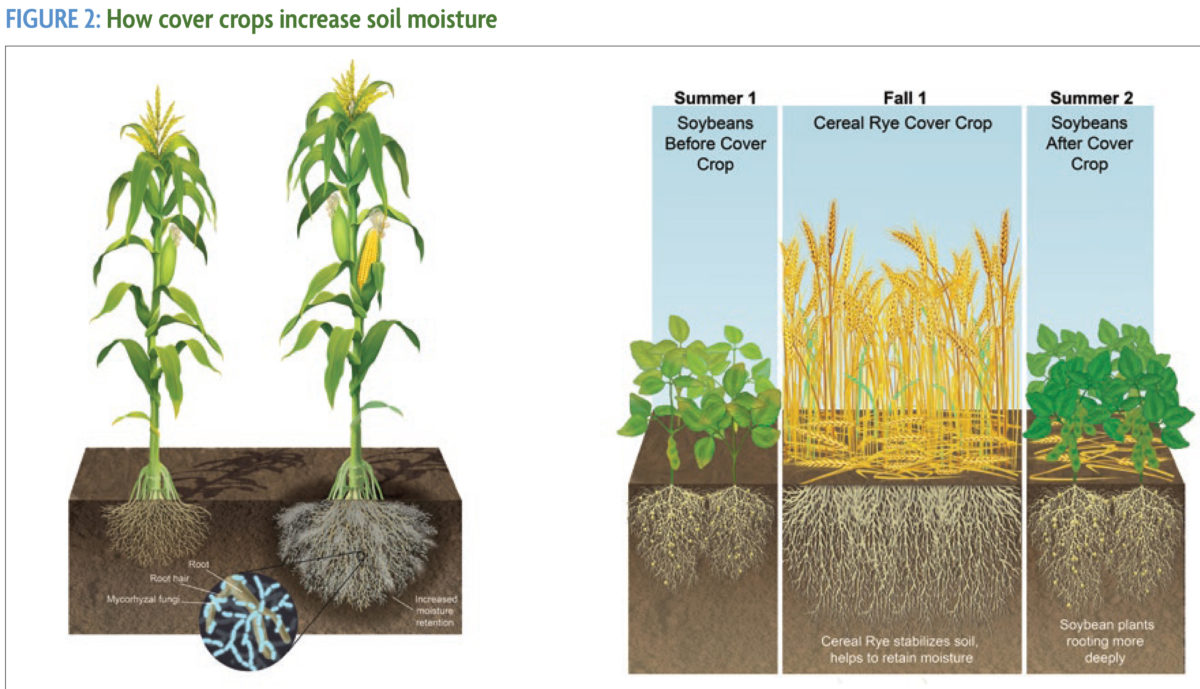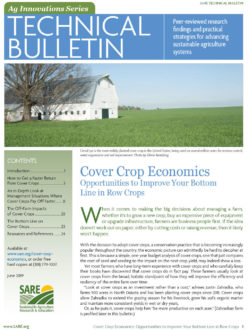One of the most dramatic examples of cover crop benefits occurred during the severe, widespread drought of 2012. On thousands of Midwestern and Western farms, crop growth suffered from rainfall levels that were far below normal. However, a pattern began to emerge when farmers found that corn or soybeans following cover crops were doing better than those in their conventional fields. This frequent observation was later supported by yield data. Farmers responding to the National Cover Crop Survey reported an average yield increase of 9.6% in corn that followed a cover crop and an increase of 11.6% in soybeans. Even more remarkable, in the seven states hit hardest by the drought, yield increases were even larger: 11% for corn and 14.3% for soybeans.
In a survey of 2,000 Midwestern and Northern Great Plains farmers, 64% said they were implementing conservation practices (no-till or reduced tillage, cover crops, etc.) as a climate risk management strategy, and another 21% were considering implementing such practices [12].
Looking just at those farmers who had one year of experience with cover crops leading up to the drought, their average yield increase in cover-cropped fields was 6% for corn and 11.4% for soybeans. With the high prices after harvest that year (national average prices of $6.89 for corn and $14.40 for soybeans), cover crops more than paid for themselves in the 2012 drought year, even after just one year of use. Note that this conclusion is based on average yield response, using the survey regression analysis on yields. A small portion of individual fields and farms had yield losses following cover crops, while others had even larger yield increases.
There are several reasons that cover crops can increase soil moisture and reduce yield losses caused by drought (Figure 2). One reason is that cover crops help improve rainfall infiltration through an increased number of macropores, both from cover crop roots and from increased earthworm activity. Once the rain has soaked into the soil, it is more likely to stay in the root zone, partly because the cover crop residue on the soil surface reduces evaporation. That residue can also keep the soil cooler, which further reduces moisture loss and crop stress, and allows soil microbes to operate more beneficially. Over time, improving soil health can lead to increased moisture-holding capacity in the soil as organic matter increases and soil aggregate structure improves. However, even in the short term, cover crops can stimulate mycorrhizal fungi, and those fungi can help drought-shortened crop roots better access moisture and nutrients.

Cover crops can increase soil moisture in a number of ways: stimulating the growth of mycorrhizal fungi on crop roots, providing surface residue, creating root channels for the following crop to use, and improving both rainfall infiltration and the soil’s water-holding capacity. Illustrations by Carlyn Iverson
Cover crops can pay significant dividends by improving soil moisture management in fields that often suffer from moisture stress, such as lighter-textured soils or fields in marginal rainfall areas. The improved infiltration from cover crops can also increase the efficiency of irrigation and reduce evaporation. Steve Stevens, an Arkansas cotton farmer, estimated that when he uses cover crops he can save about $0.06 per pound of cotton produced ($60 per acre) through reduced irrigation expenses [9].
Noah Williams, who farms 2,800 dryland acres in eastern Oregon, has found cover crops to be a benefit even though he has very limited rainfall. Working with his local USDA Natural Resources Conservation Service (NRCS) soil conservationist, Williams monitored soil moisture levels in fields left fallow and in fields planted to cover crops in place of fallow. Overall, soil moisture was about the same between fallow and the cover crops. But after a rain, Williams observed that the moisture reached the two-foot depth zone of the soil profile in his cover cropped fields, whereas that zone was dry in the fallow system. When combined with grazing, Williams says, “Cover crops are paying for the cost of seeding.”
Snapshot: The financial impact of cover crops during a drought
Based on data from the 2012 drought, cover crops significantly boost yield (on average) during a drought year, and cover crops pay off in year one. Returns for corn average $27.34, $77.15 and $110.45 per acre after one, three and five years of planting cover crops. Soybean returns average $41.69, $70.22 and $84.54 per acre after one, three and five years. (See Table 4 and Table 5 for details.) For the purpose of this analysis, the one-, three- and five-year increments mean that cover crops had been used for that amount of time when a drought occurred.
